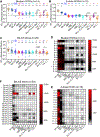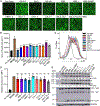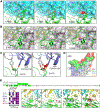Enhanced evasion of neutralizing antibody response by Omicron XBB.1.5, CH.1.1, and CA.3.1 variants
- PMID: 37104089
- PMCID: PMC10279473
- DOI: 10.1016/j.celrep.2023.112443
Enhanced evasion of neutralizing antibody response by Omicron XBB.1.5, CH.1.1, and CA.3.1 variants
Abstract
Omicron subvariants continuingly challenge current vaccination strategies. Here, we demonstrate nearly complete escape of the XBB.1.5, CH.1.1, and CA.3.1 variants from neutralizing antibodies stimulated by three doses of mRNA vaccine or by BA.4/5 wave infection, but neutralization is rescued by a BA.5-containing bivalent booster. CH.1.1 and CA.3.1 show strong immune escape from monoclonal antibody S309. Additionally, XBB.1.5, CH.1.1, and CA.3.1 spike proteins exhibit increased fusogenicity and enhanced processing compared with BA.2. Homology modeling reveals the key roles of G252V and F486P in the neutralization resistance of XBB.1.5, with F486P also enhancing receptor binding. Further, K444T/M and L452R in CH.1.1 and CA.3.1 likely drive escape from class II neutralizing antibodies, whereas R346T and G339H mutations could confer the strong neutralization resistance of these two subvariants to S309-like antibodies. Overall, our results support the need for administration of the bivalent mRNA vaccine and continued surveillance of Omicron subvariants.
Keywords: CA.3.1; CH.1.1; CP: Immunology; CP: Microbiology; Omicron subvariants; XBB.1.5; fusogenicity; immune evasion; mAb S309; neutralizing antibody.
Copyright © 2023 The Author(s). Published by Elsevier Inc. All rights reserved.
Conflict of interest statement
Declaration of interests The authors declare no competing interests.
Figures




Update of
-
Extraordinary Evasion of Neutralizing Antibody Response by Omicron XBB.1.5, CH.1.1 and CA.3.1 Variants.bioRxiv [Preprint]. 2023 Jan 17:2023.01.16.524244. doi: 10.1101/2023.01.16.524244. bioRxiv. 2023. Update in: Cell Rep. 2023 May 30;42(5):112443. doi: 10.1016/j.celrep.2023.112443. PMID: 36711991 Free PMC article. Updated. Preprint.
Similar articles
-
Continued evasion of neutralizing antibody response by Omicron XBB.1.16.Cell Rep. 2023 Oct 31;42(10):113193. doi: 10.1016/j.celrep.2023.113193. Epub 2023 Sep 30. Cell Rep. 2023. PMID: 37777967 Free PMC article.
-
Extraordinary Evasion of Neutralizing Antibody Response by Omicron XBB.1.5, CH.1.1 and CA.3.1 Variants.bioRxiv [Preprint]. 2023 Jan 17:2023.01.16.524244. doi: 10.1101/2023.01.16.524244. bioRxiv. 2023. Update in: Cell Rep. 2023 May 30;42(5):112443. doi: 10.1016/j.celrep.2023.112443. PMID: 36711991 Free PMC article. Updated. Preprint.
-
Neutralization escape of Omicron XBB, BR.2, and BA.2.3.20 subvariants.Cell Rep Med. 2023 May 16;4(5):101049. doi: 10.1016/j.xcrm.2023.101049. Epub 2023 Apr 25. Cell Rep Med. 2023. PMID: 37148877 Free PMC article.
-
Immune Evasion of SARS-CoV-2 Omicron Subvariants XBB.1.5, XBB.1.16 and EG.5.1 in a Cohort of Older Adults after ChAdOx1-S Vaccination and BA.4/5 Bivalent Booster.Vaccines (Basel). 2024 Jan 30;12(2):144. doi: 10.3390/vaccines12020144. Vaccines (Basel). 2024. PMID: 38400128 Free PMC article.
-
Immune evasion and membrane fusion of SARS-CoV-2 XBB subvariants EG.5.1 and XBB.2.3.Emerg Microbes Infect. 2023 Dec;12(2):2270069. doi: 10.1080/22221751.2023.2270069. Epub 2023 Oct 26. Emerg Microbes Infect. 2023. PMID: 37819267 Free PMC article.
Cited by
-
Long-Term Immunity against SARS-CoV-2 Wild-Type and Omicron XBB.1.5 in Indonesian Residents after Vaccination and Infection.Antibodies (Basel). 2024 Sep 2;13(3):72. doi: 10.3390/antib13030072. Antibodies (Basel). 2024. PMID: 39311377 Free PMC article.
-
An updated review of epidemiological characteristics, immune escape, and therapeutic advances of SARS-CoV-2 Omicron XBB.1.5 and other mutants.Front Cell Infect Microbiol. 2023 Dec 14;13:1297078. doi: 10.3389/fcimb.2023.1297078. eCollection 2023. Front Cell Infect Microbiol. 2023. PMID: 38156316 Free PMC article. Review.
-
A Recombinant Protein XBB.1.5 RBD/Alum/CpG Vaccine Elicits High Neutralizing Antibody Titers against Omicron Subvariants of SARS-CoV-2.Vaccines (Basel). 2023 Oct 1;11(10):1557. doi: 10.3390/vaccines11101557. Vaccines (Basel). 2023. PMID: 37896960 Free PMC article.
-
Continued evasion of neutralizing antibody response by Omicron XBB.1.16.Cell Rep. 2023 Oct 31;42(10):113193. doi: 10.1016/j.celrep.2023.113193. Epub 2023 Sep 30. Cell Rep. 2023. PMID: 37777967 Free PMC article.
-
Broad Epitope Coverage of Therapeutic Multi-Antibody Combinations Targeting SARS-CoV-2 Boosts In Vivo Protection and Neutralization Potency to Corner an Immune-Evading Virus.Biomedicines. 2024 Mar 13;12(3):642. doi: 10.3390/biomedicines12030642. Biomedicines. 2024. PMID: 38540255 Free PMC article.
References
-
- Yuan S, Ye Z-W, Liang R, Tang K, Zhang AJ, Lu G, Ong CP, Man Poon VK, Chan CCS, Mok BWY, et al. (2022). Pathogenicity, transmissibility, and fitness of SARS-CoV-2 Omicron in Syrian hamsters.Science 377, 428–433. - PubMed
Publication types
MeSH terms
Substances
Grants and funding
LinkOut - more resources
Full Text Sources
Other Literature Sources
Miscellaneous

